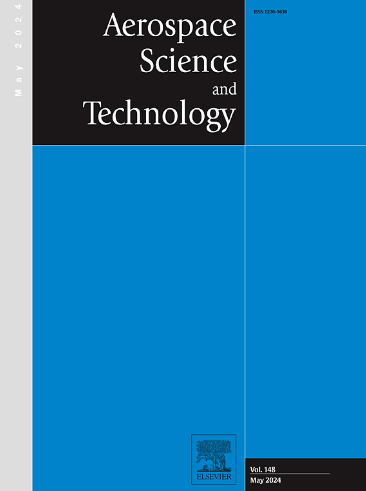Planform-customized waverider design using flows with variable mach numbers
IF 5
1区 工程技术
Q1 ENGINEERING, AEROSPACE
引用次数: 0
Abstract
The traditional waverider is usually designed in a single design state. Thus, the performance advantage of the high lift-to-drag ratio (L/D) is difficult to maintain when a waverider deviates from the design state, limiting its application in wide-speed aerodynamic design. In this paper, by employing the conical flows with different Mach numbers in different osculating planes, the planform-customized waverider design using variable-Mach-number flows is proposed based on the osculating-cone treatment. Then the double swept waveriders, which shared the same leading-edge profile, were generated with different spanwise distributions of Mach numbers. Computational Fluid Dynamics techniques were employed to analyze the aerodynamic forces, longitudinal stabilities, and shock wave structures of the waveriders. Compared with the conventional waveriders using fixed conical flows, the wide-speed performances of this planform-customized waverider were analyzed in hypersonic regime. Results showed that the planform-customized waverider design using variable-Mach-number flows is feasible, enlarging design space efficiently. Over a wide range of hypersonic velocities, the waverider using the flows with variable Mach numbers featured balanced L/D and volume efficiencies. When the planform shapes were identical, however, the difference in aerodynamic centers between the variable-Mach-number and fixed-Mach-number waveriders was significantly slight. The slight difference indicates that the variable-Mach-number flows as basis flows had mere effect on longitudinal stability. Meanwhile, compared with the fixed-Mach-number waveriders with equal volume and identical planform shape, the wide-speed L/D ratios of the variable-Mach-number waveriders were not superior in hypersonic regime.
使用可变马赫数流的平台定制乘波器设计
传统的乘波器通常在单一设计状态下设计。因此,当乘波器偏离设计状态时,其高升阻比(L/D)的性能优势难以保持,限制了其在高速气动设计中的应用。本文利用不同接触面中不同马赫数的锥形流,提出了基于接触锥处理的变马赫数流的平台定制乘波器设计。然后,采用不同的展向马赫数分布,生成了具有相同前缘型线的双掠型乘波体。采用计算流体力学技术对乘波器的气动力、纵向稳定性和激波结构进行了分析。与采用固定锥流的传统乘波器相比,分析了该平台定制乘波器在高超声速工况下的宽速性能。结果表明,采用变马赫数流的平台定制乘波器设计是可行的,有效地扩大了设计空间。在很大的高超音速范围内,使用可变马赫数流的乘波机具有平衡的L/D和体积效率的特点。然而,当平台形状相同时,可变马赫数和固定马赫数乘波器之间的气动中心差异非常小。这一微小差异表明,变马赫数流作为基流对纵向稳定性影响不大。同时,在高超声速工况下,变马赫数型的宽速L/D比并不优于等体积、同平面形状的定马赫数型。
本文章由计算机程序翻译,如有差异,请以英文原文为准。
求助全文
约1分钟内获得全文
求助全文
来源期刊

Aerospace Science and Technology
工程技术-工程:宇航
CiteScore
10.30
自引率
28.60%
发文量
654
审稿时长
54 days
期刊介绍:
Aerospace Science and Technology publishes articles of outstanding scientific quality. Each article is reviewed by two referees. The journal welcomes papers from a wide range of countries. This journal publishes original papers, review articles and short communications related to all fields of aerospace research, fundamental and applied, potential applications of which are clearly related to:
• The design and the manufacture of aircraft, helicopters, missiles, launchers and satellites
• The control of their environment
• The study of various systems they are involved in, as supports or as targets.
Authors are invited to submit papers on new advances in the following topics to aerospace applications:
• Fluid dynamics
• Energetics and propulsion
• Materials and structures
• Flight mechanics
• Navigation, guidance and control
• Acoustics
• Optics
• Electromagnetism and radar
• Signal and image processing
• Information processing
• Data fusion
• Decision aid
• Human behaviour
• Robotics and intelligent systems
• Complex system engineering.
Etc.
 求助内容:
求助内容: 应助结果提醒方式:
应助结果提醒方式:


